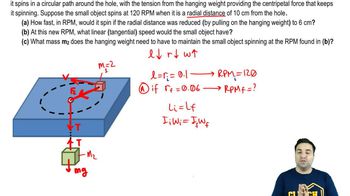Here are the essential concepts you must grasp in order to answer the question correctly.
Frequency and Pitch
Frequency refers to the number of oscillations or cycles per second of a wave, measured in Hertz (Hz). In musical terms, higher frequencies correspond to higher pitches. For example, the A string at 440 Hz produces a pitch that is perceived as higher than the E string at 659 Hz, which is even higher. Understanding this relationship is crucial for analyzing how string tension and mass affect sound production.
Recommended video:
Circumference, Period, and Frequency in UCM
Tension and Frequency Relationship
The frequency of a vibrating string is influenced by its tension, length, and mass per unit length. The fundamental frequency (f) of a string can be expressed as f = (1/2L) * √(T/μ), where L is the length, T is the tension, and μ is the mass per unit length. Since the strings are of the same length and tension, the frequency is inversely proportional to the square root of the mass per unit length, which allows us to derive the mass ratio from the frequency ratio.
Recommended video:
Circumference, Period, and Frequency in UCM
Mass per Unit Length
Mass per unit length (μ) is a critical factor in determining the frequency of a vibrating string. It is defined as the mass of the string divided by its length. In this scenario, since the A and E strings are of equal length and tension, their frequencies can be used to find the ratio of their masses. The relationship μ ∝ 1/f² indicates that if the frequency increases, the mass per unit length must decrease, allowing us to calculate the mass ratio based on the given frequencies.
Recommended video:
Spinning on a string of variable length



